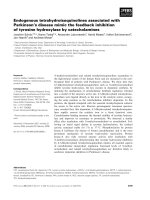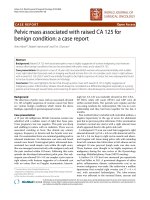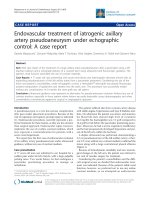Báo cáo khoa học: "Pelvic mass associated with raised CA 125 for benign condition: a case report" potx
Bạn đang xem bản rút gọn của tài liệu. Xem và tải ngay bản đầy đủ của tài liệu tại đây (255.59 KB, 3 trang )
WORLD JOURNAL OF
SURGICAL ONCOLOGY
Asher et al. World Journal of Surgical Oncology 2010, 8:28
/>Open Access
CASE REPORT
BioMed Central
© 2010 Asher et al; licensee BioMed Central Ltd. This is an Open Access article distributed under the terms of the Creative Commons
Attribution License ( which permits unrestricted use, distribution, and reproduction in
any medium, provided the original work is properly cited.
Case report
Pelvic mass associated with raised CA 125 for
benign condition: a case report
Viren Asher*
1
, Robert Hammond
2
and Tim J Duncan
3
Abstract
Background: Raised CA 125 with associated pelvic mass is highly suggestive of ovarian malignancy, but there are
various other benign conditions that can be associated with pelvic mass and a raised CA 125.
Case presentation: We present a case of 19 year old, Caucasian British woman who presented initially with sudden
onset right sided iliac fossa pain and on imaging was found to have 9.8 × 4.5 cm complex cystic mass in right adnexa
with a raised CA 125 of 657, which was initially thought to be highly suspicious of cancer but was subsequently found
to be due to pelvic inflammatory disease on histology.
Conclusion: This case highlights the fact that though a pelvic mass with raised CA 125 is highly suggestive of
malignancy, pelvic inflammatory disease should always be considered as a differential diagnosis especially in a young
patient and a thorough sexual history and screening for pelvic infection should always be carried out in these patients.
Background
The detection of pelvic mass with an associated elevated
CA 125 is highly suspicious of ovarian cancer, but there
are various benign conditions which mimic the above
findings, especially in premenopausal women.
Case presentation
A 19 year old nulliparous, British Caucasian woman was
admitted with a sudden onset of right iliac fossa pain.
Urine pregnancy test was negative. This pain was sharp
and stabbing in nature with no radiation. There was no
associated vomiting or fever. She denied any urinary
urgency, frequency or dysuria and her bowels were nor-
mal. On examination there was minimal guarding and no
rebound tenderness. No distension was seen and bowel
sounds were heard. Transvaginal pelvic ultrasound dem-
onstrated two small simple cysts within the right ovary.
She was managed conservatively with analgesics only and
the pain resolved within 24 hours. Following this acute
episode she developed intermittent pelvic pain. Her sub-
sequent scan showed 9.8 × 4.5 cm complex cystic mass in
right adnexa with features suggestive of a dermoid cyst
with no colour flow on Doppler examination. Interest-
ingly her CA 125 was markedly elevated at 657; CEA,
FP, HCG, white cell count (WCC) and CRP were all
within normal limits. Her periods were regular and she
was using condoms for contraception. She was in a new
relationship and they had been together for the last 4
months.
Past medical history included well controlled asthma, a
negative laparotomy at the age of seven for abdominal
pain but no previous pelvic infections. Pelvic examination
revealed a normal size uterus with a right adnexal mass
which appeared fixed to the pelvic side wall.
A subsequent CT scan one week later suggested a right
adnexal dermoid cyst 5.4 × 4.8 cm with abnormal soft tis-
sue 3.0 × 2.6 cm deep to right rectus muscle and abnor-
mal irregular soft tissue along pelvic side wall extending
from left common iliac bifurcation to left adnexa and an
enlarged 10 mm precaval lymph node was also seen.
These features were thought to be highly suspicious of
malignancy during the case review at the Gynaecology
oncology Multidisciplinary Team (MDT) meeting.
A further CA 125 level was measured pre-operatively
and had fallen to 342. A provisional diagnosis of either
pelvic inflammatory disease, endometriotic cyst or an
ovarian malignancy was made. She underwent a midline
laparotomy that revealed right ovarian cyst (7 × 6 × 6
cm), with associated hydrosalpinx. The tubo-ovarian
mass was adherent to the terminal ileum, caecum and
* Correspondence:
1
Department of Obstetrics and Gynaecology, Royal Derby Hospital, Uttoxeter
road, Derby DE22 3NE, UK
Full list of author information is available at the end of the article
Asher et al. World Journal of Surgical Oncology 2010, 8:28
/>Page 2 of 3
omentum with appendix buried in the mass. The left
ovary was normal, although there was evidence of a left
pyosalpinx, which was drained to conserve left tube. A
right salpingo-opherectomy, appendicectomy and omen-
tal biopsy was performed and an intraoperative swab
from the mass was sent for culture and sensitivity. She
had high vaginal, endocervical and Chlamydia swabs
postoperatively and her recovery was uneventful.
Histology revealed a benign cystic ovarian teratoma,
the fallopian tube showed acute on chronic salpingitis
and the appendix was normal. The post operative endo-
cervical swab was positive for Chlamydia. Both the part-
ners were then subsequently referred to Genito- urinary
clinic for ongoing treatment and contact tracing.
Discussion
Ovarian cancer is the second most common female
gynaecological cancer in the UK with 6,806 cases
detected in 2005 and the lifetime risk of developing the
disease is 1 in 48 [1]. The majority of these are detected in
advanced stages contributing to the poor prognosis of
this disease[2]. The incidence of ovarian cancer is low in
young women and epithelial ovarian cancers are not
known to occur before menarche, and most of them
(though rare) are germ cell tumour, juvenile granulosa
cell tumour and serous borderline tumours. Age specific
incidence is 40/100,000 by the age of 50 and rises to 50
per 100,000 women by the age of 65 yrs[3].
For early detection of ovarian cancer various tumour
markers have been studied and CA 125 has been pro-
posed by Bast et al[4] as a relatively specific marker for
ovarian cancer. The CA 125 molecule is a 200-kDa glyco-
protien and was initially identified on the surface of the
ovarian carcinoma cell line OVCA433[5]. CA 125 is
widely distributed on the surface of both healthy and
malignant cells of mesothelial origin, including pleural,
pericardial, peritoneal and endometrial cells, as well as in
normal genital tract and amniotic membrane. Interest-
ingly the molecule is not present on the surface of normal
ovarian cells, but is present in 80% of malignant ovarian
tissue of non mucinous origin[3]. The value of CA 125
varies between laboratories depending on the type of
assay used but levels < 35 kIU/L are considered to be nor-
mal[6].
In view of wide distribution of CA 125 expression,
serum CA 125 levels can be raised in various benign and
inflammatory conditions such as menstruation, preg-
nancy, endometriosis, pelvic inflammatory disease and
non- gynaecological conditions including various liver
and pulmonary diseases.
Differentiating benign from early malignant ovarian
disease is important and provides a diagnostic challenge.
The combination of pelvic mass and elevated level CA
125 arouses suspicion of a gynaecological malignancy,
but other conditions should always be considered in the
differential diagnosis, especially in a pre menopausal
female. Malkasion[7] studied 59 patients with histologi-
cally proven benign ovarian cysts. Out of these patients
17 had elevated concentrations of CA 125 (12 > 35 units/
ml, 4 > 65 units/ml and 1 > 2000 units/ml). In another
study by Dixia[8] using 153 patients with benign pelvic
masses, 10 patients had CA 125 concentrations >188
units/ml and one patient had a value of more that 400
units/ml. Nolen et al screened 65 biomarkers in patients
with adnexal masses and more than half of the biomark-
ers differed significantly between benign and malignant
masses. CA 125 and HE4 in combination provided the
highest discrimination between benign and malignant
cases[9]. These studies demonstrate that using CA 125 in
isolation has a limited value in differentiating benign
from malignant pelvic masses. The patient characteristics
and radiological information provides crucial additional
information on which to base a diagnosis.
Pelvic ultrasound in conjunction with CA 125 repre-
sents the most frequently utilised investigations for
patients with adnexal masses. CT scan has limited value
in the initial assessment of adnexal masses due to poor
soft tissue discrimination and with disadvantages for irra-
diation[10], but can help to assess the extent of disease in
the upper abdomen prior to primary cytoreduction and
following chemotherapy to detect resistant disease or
recurrence[11]. The CT scan in the current case was mis-
leading, with irregular pelvic side wall soft tissue and pre-
caval lymph node assumed to be malignant most likely
representing inflammation from the Chlamydia infection.
MRI has also been suggested to be helpful in detection of
organ of origin for pelvic masses. MRI has a sensitivity of
96% while it was only 77% for Ultrasound and 87% for CT
for detection of pelvic masses. MRI has been shown to
correctly identify organ of origin in 94% compared to
only 66% of Ultrasound[12]. Review of literature from
1990 to 2006 which included 143 studies showed that
Ultrasound findings were similar to CT and MRI in dif-
ferentiation of benign from malignant ovarian
masses[13]. Currently newer imaging in the form of Posi-
tron emission tomography (PET) and CT can be used to
judge the extent of the disease and also differentiate
between malignant and benign masses [14]. As it is evi-
dent from above studies all the modalities are compli-
mentary to each other with ultrasound remaining the
first diagnostic modality as it is cheap and widely avail-
able in all units. Further assessment of the spread of dis-
ease can either be made by CT or MRI and PET scanning
where facilities exist.
As the CA 125 molecule is identified in normal perito-
neal and fallopian tubes, it is not surprising that inflam-
Asher et al. World Journal of Surgical Oncology 2010, 8:28
/>Page 3 of 3
mation of these tissues can result in an increased
concentration of serum CA 125. Ruibal et al[15] found
that nine of twelve women with suspected peritonitis had
CA 125 concentrations of > 65 units/ml with two patients
having value > 500 units/ml. A more definitive study
examined CA 125 values in 30 patients with pelvic
inflammatory disease associated with fever who had a
good response to antibiotic therapy. CA 125 > 100 units/
ml was seen in 5 patients (17%) and the highest value was
550 units/ml[16]. This increased serum concentration of
CA 125 can be explained by the local expression by the
inflamed tissue. Another study of 33 patients with pelvic
inflammatory disease showed that 32 patients had
increased concentrations of CA 125 with values between
100 and 1300 units/ml[17].
In the current case the key finding of a reduction in CA
125 between the serial measurements suggested that the
elevation witnessed may be of benign origin. This is
reflected in the well documented exponential rise in CA
125 levels described in ovarian malignancy[18].
Conclusion
The presence of a pelvic mass with a raised CA 125 of 657
units/ml, lymphadenopathy and other associated suspi-
cious features on CT scan suggested an ovarian malig-
nancy. A subsequent fall of CA 125 to 342 units/ml
pointed to an inflammatory or benign condition. The
mass on laparotomy was found to be associated with pel-
vic inflammatory disease. Raised CA 125 levels can be
misleading, as illustrated in this case, a differential diag-
nosis of pelvic inflammatory condition should always be
considered in young patients. These patients when pres-
ent with adnexal mass, it is important to elicit a detailed
sexual history with specific emphasis on previous pelvic
inflammatory disease. Screening women for pelvic infec-
tion using a high vaginal swab, endocervical swab and
Chlamydia swab, when presenting with pelvic pain is
essential, even if a likely cause such as a pelvic mass is
already detected.
Consent
Written informed consent has been obtained from the
patient for publication of this case report.
Competing interests
The authors declare that they have no competing interests.
Authors' contributions
VH was involved in pre and post operative care of the patient and wrote the
manuscript. RH and TJD performed the surgery and helped in correction of the
manuscript. All authors have read, approved and contributed towards the
manuscript.
Author Details
1
Department of Obstetrics and Gynaecology, Royal Derby Hospital, Uttoxeter
road, Derby DE22 3NE, UK,
2
Department of Gynaecological oncology,
Nottingham City Hospital, Hucknall road, Nottingham NG5 1PB, UK and
3
Department of Gynaecological Oncology, Norfolk and Norwich University
Hospitals NHS Trust, Conley Lane, Norwich, Norfolk, UK
References
1. Cancer Research 2005 [
]
2. DeVita VTHS, Rosenberg SA: Principles and Practice of Oncology. 1982
edition. Edited by: KR Perez CA, Young RC. Philadelphia: JB Lippioncott;
1982.
3. Westhoff C: Ovarian cancer. Annu Rev Public Health 1996, 17:85-96.
4. Bast RC Jr, Klug TL, St John E, Jenison E, Niloff JM, Lazarus H, Berkowitz RS,
Leavitt T, Griffiths CT, Parker L, Zurawski VR Jr, Knapp RC: A
radioimmunoassay using a monoclonal antibody to monitor the
course of epithelial ovarian cancer. N Engl J Med 1983, 309(15):883-7.
5. Bast RC Jr, Feeney M, Lazarus H, Nadler LM, Colvin RB, Knapp RC:
Reactivity of a monoclonal antibody with human ovarian carcinoma. J
Clin Invest 1981, 68(5):1331-7.
6. Jacobs I, Bast RC Jr: The CA 125 tumour-associated antigen: a review of
the literature. Hum Reprod 1989, 4(1):1-12.
7. Malkasian GD Jr, Knapp RC, Lavin PT, Zurawski VR Jr, Podratz KC, Stanhope
CR, Mortel R, Berek JS, Bast RC Jr, Ritts RE: Preoperative evaluation of
serum CA 125 levels in premenopausal and postmenopausal patients
with pelvic masses: discrimination of benign from malignant disease.
Am J Obstet Gynecol 1988, 159(2):341-6.
8. Chen DX, Schwartz PE, Li XG, Yang Z: Evaluation of CA 125 levels in
differentiating malignant from benign tumors in patients with pelvic
masses. Obstet Gynecol 1988, 72(1):23-7.
9. Nolen B, et al.: Serum biomarker panels for the discrimination of benign
from malignant cases in patients with an adnexal mass. Gynecol Oncol
in press.
10. Togashi K: Ovarian cancer: the clinical role of US, CT, and MRI. Eur Radiol
2003, 13(Suppl 4):L87-104.
11. Jeong YY, Outwater EK, Kang HK: Imaging evaluation of ovarian masses.
Radiographics 2000, 20(5):1445-70.
12. Balan P: Ultrasonography, computed tomography and magnetic
resonance imaging in the assessment of pelvic pathology. Eur J Radiol
2006, 58(1):147-55.
13. Liu J, Xu Y, Wang J: Ultrasonography, computed tomography and
magnetic resonance imaging for diagnosis of ovarian carcinoma. Eur J
Radiol 2007, 62(3):328-34.
14. Risum S, Høgdall C, Loft A, Berthelsen AK, Høgdall E, Nedergaard L,
Lundvall L, Engelholm SA: The diagnostic value of PET/CT for primary
ovarian cancer a prospective study. Gynecol Oncol 2007, 105(1):145-9.
15. Ruibal A, Encabo G, Martinéz-Miralles E, Murcia C, Capdevila JA, Salgado A,
Martinéz-Vasquéz JM: CA 125 seric levels in non malignant pathologies.
Bull Cancer 1984, 71(2):145-6.
16. Halila H, Stenman UH, Seppala M: Ovarian cancer antigen CA 125 levels
in pelvic inflammatory disease and pregnancy. Cancer 1986,
57(7):1327-9.
17. Paavonen J, Miettinen A, Heinonen PK, Aaran RK, Teisala K, Aine R,
Punnonen R, Laine S, Kallioniemi OP, Lehtinen M: Serum CA 125 in acute
pelvic inflammatory disease. Br J Obstet Gynaecol 1989, 96(5):574-9.
18. Jacobs IJ, Skates S, Davies AP, Woolas RP, Jeyerajah A, Weidemann P,
Sibley K, Oram DH: Risk of diagnosis of ovarian cancer after raised
serum CA 125 concentration: a prospective cohort study. BMJ 1996,
313(7069):1355-8.
doi: 10.1186/1477-7819-8-28
Cite this article as: Asher et al., Pelvic mass associated with raised CA 125 for
benign condition: a case report World Journal of Surgical Oncology 2010, 8:28
Received: 3 February 2010 Accepted: 16 April 2010
Published: 16 April 2010
This article is available from: 2010 Asher et al; licensee BioMed Central Ltd. This is an Open Access article distributed under the terms of the Creative Commons Attribution License ( which permits unrestricted use, distribution, and reproduction in any medium, provided the original work is properly cited.World Journal of Surgical Oncology 2010, 8:28









